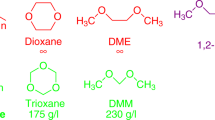Abstract
There is much evidence both from atmospheric1–9 and laboratory10,11 measurements that water vapour can show absorption of millimetre waves in addition to that predicted by models based on monomers12 and dimers13. Constituents other than water can be eliminated as the cause of the extra absorption which is characterized by having a structured spectrum, increasing more rapidly with decreasing temperature than is expected from equilibrium phenomena and in the atmosphere showing a highly variable strength which is not simply correlated with total water content. The steep temperature dependence suggests invoking non-equilibrium water species to provide an explanation and this will account for variability as well as giving new prospects for understanding the spectral structure. A non-equilibrium model has, however, to be reconciled with what is known about supersaturation. It also opens the question of the nature of the energy source which is maintaining the steady state and allowing the extra absorption to be observed. I suggest here that water polymers containing about 50 molecules can, by collective acoustic resonances and postulated transition dipole moments, explain the observed component of absorption of millimetre waves by the atmosphere in some conditions. The polymers are metastable and are almost certainly the cause of supersaturation in cloud chambers but in these their lifetime is much greater than in the atmosphere.
This is a preview of subscription content, access via your institution
Access options
Subscribe to this journal
Receive 51 print issues and online access
$199.00 per year
only $3.90 per issue
Buy this article
- Purchase on Springer Link
- Instant access to full article PDF
Prices may be subject to local taxes which are calculated during checkout
Similar content being viewed by others
References
Gebbie, H. A. & Burroughs, W. J Nature 217, 1241 (1968).
Nolt, I. G., Martin, T. Z., Wood, C. W. & Sinton, W. M. J. atmos. Sci. 28, 238–241 (1971).
Burroughs, W. J. & Chamberlain, J. Infrared Phys. 10, 165 (1970).
Gimmestad, G. G., Ware, R. H., Bohlander, R. A. & Gebbie, H. A. Astrophys. J. 218, 311 (1977).
Moffat, P., Bohlander, R. A., McCrae, W. R. & Gebbie, H. A. Nature 269, 676–677 (1977).
Gebbie, H. A., Bohlander, R. A. & Pardoe, G. W. F. Nature 230, 522 (1971).
Gimmestad, G. G. & Gebbie, H. A. J. atmos. ten. Phys. 38, 325–328 (1976).
Emery, R. J., Moffat, P., Bohlander, R. A. & Gebbie, H. A. J. atmos. terr. Phys. 37, 587–594 (1975).
Emery, R. J., Zavody, A. M. & Gebbie, H. A. J. atmos. terr. Phys. 42, 801–807 (1980).
Llewellyn-Jones, D. T., Knight, R. J. & Gebbie, H. A. J. Phys. E9, 690–692 (1976).
Llewellyn-Jones, D. T., Knight, R. J. & Gebbie, H. A. Nature 274, 876–878 (1978).
McClatchey, R. A. et al. AFCRL Atmospheric Absorption Line Parameters Compilation (AFCRL-TR-73-0096, 1973).
Bohlander, R. A., thesis, Univ. London (1979).
Mather, J. C., Werner, M. W. & Richards, P. L. Astrophys. J. Lett. 170, L59 (1971).
Rice, D. P. & Ade, P. A. R. Infrared Phys. 19, 575–584 (1979).
Frenkel, J. Kinetic Theory of Liquids (Oxford University Press, 1946).
Landau, L. D. & Lifshitz, E. M. Course of Theoretical Physics Vol. 6 (Pergamon, Oxford, 1959).
Tolman, R. C. J. chem. Phys. 17, 118 and 333 (1949).
Mason, B. J. The Physics of Clouds, 2nd edn (Oxford University Press, London, 1971).
Bohlander, R. A. & Gebbie, H. A. Nature 253, 523–525 (1975).
Plummer, P. L. M. & Hale, B. N. J. chem. Phys. 56, 4329–4333 (1972).
Biraud, Y., Gay, J., Verdet, J. P. & Zéau, Y. Astr. Astrophys. 2, 413–419 (1969).
Baluteau, J. P., Bussoletti, E. & Epchtein, N. Nature 244, 562–563 (1973).
Zavody, A. M., Emery, R. J. & Gebbie, H. A. Nature 277, 462–463 (1979).
Weitz, D. A., Granila, T. J., Genack, A. Z. & Gersten, J. I. Phys. Rev. Lett. 45, 355–358 (1980).
Fröhlich, H. Adv. Electron. Electron Phys. 53, 85–152.
Lovesey, S. W. & Schofield, P. J. Phys. C., Solid St. Phys. 9, 2843–2856 (1975).
Szu, H. H. Phys. Fluids 21, 1243–1246 (1978).
Author information
Authors and Affiliations
Rights and permissions
About this article
Cite this article
Gebbie, H. Resonant absorption by water polymers in the atmosphere. Nature 296, 422–424 (1982). https://doi.org/10.1038/296422a0
Received:
Accepted:
Issue Date:
DOI: https://doi.org/10.1038/296422a0
This article is cited by
-
Terahertz vibrational properties of water nanoclusters relevant to biology
Journal of Biological Physics (2012)
-
On the anomalies and role of water clusters in atmospheric absorption of millimeter and submillimeter radio waves
Radiophysics and Quantum Electronics (1996)
-
Observation of a strong inverse temperature dependence for the opacity of atmospheric water vapor in the MM continuum near 280 GHz
International Journal of Infrared and Millimeter Waves (1990)
-
A theoretical evaluation of water oligomer populations in the Earth's atmosphere
Journal of Atmospheric Chemistry (1988)
-
Decomposition of atmospheric water content into cluster contributions based on theoretical association equilibrium constants
International Journal of Thermophysics (1987)
Comments
By submitting a comment you agree to abide by our Terms and Community Guidelines. If you find something abusive or that does not comply with our terms or guidelines please flag it as inappropriate.



